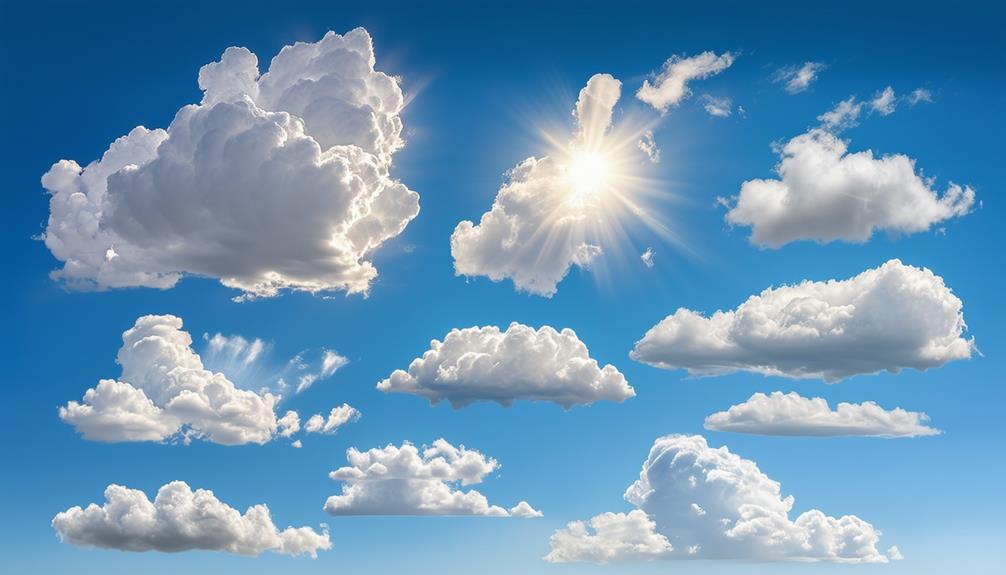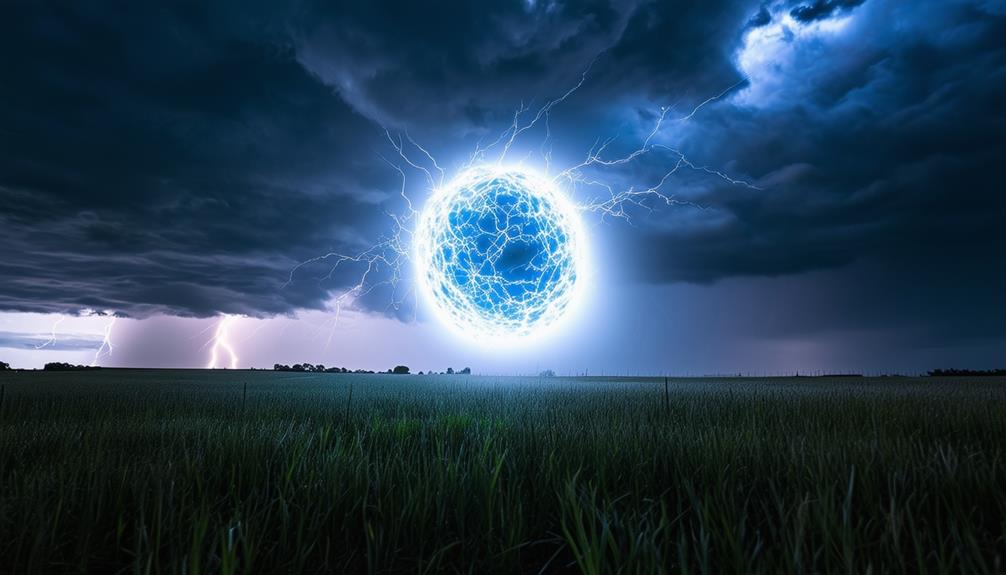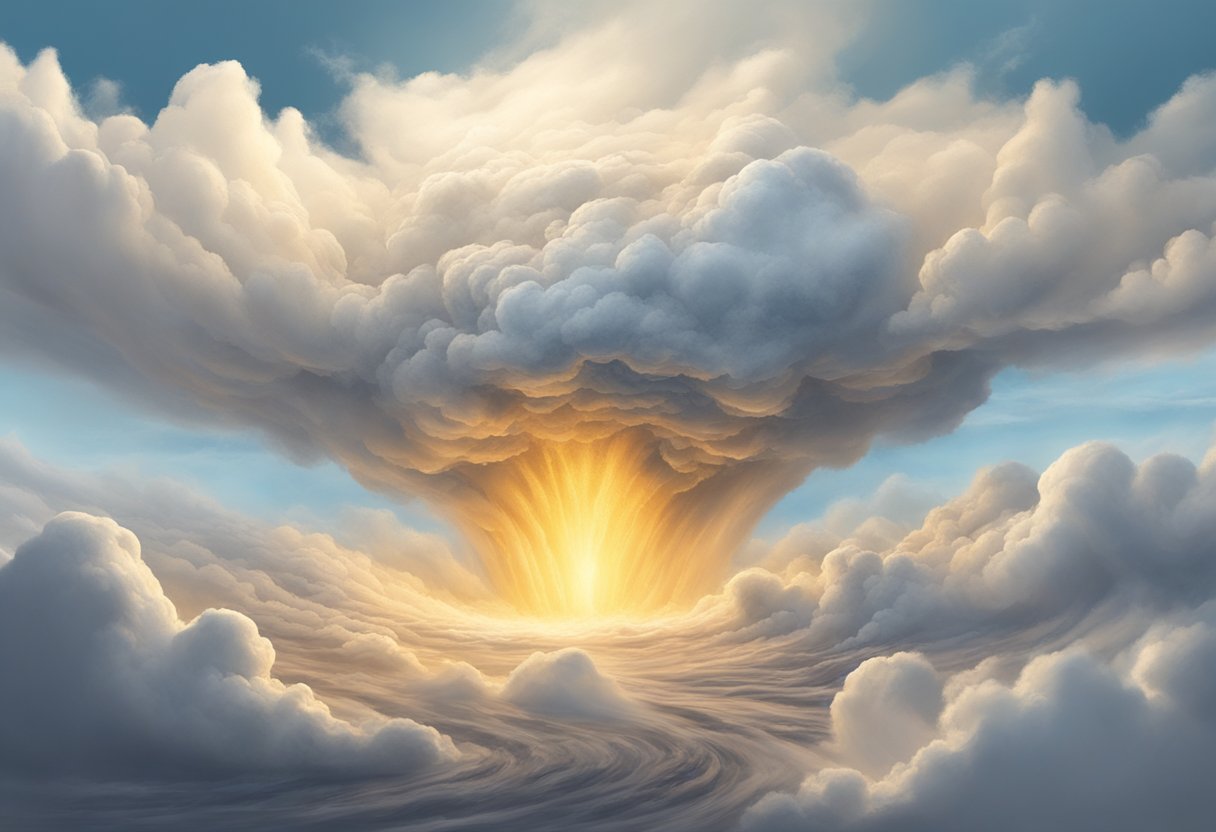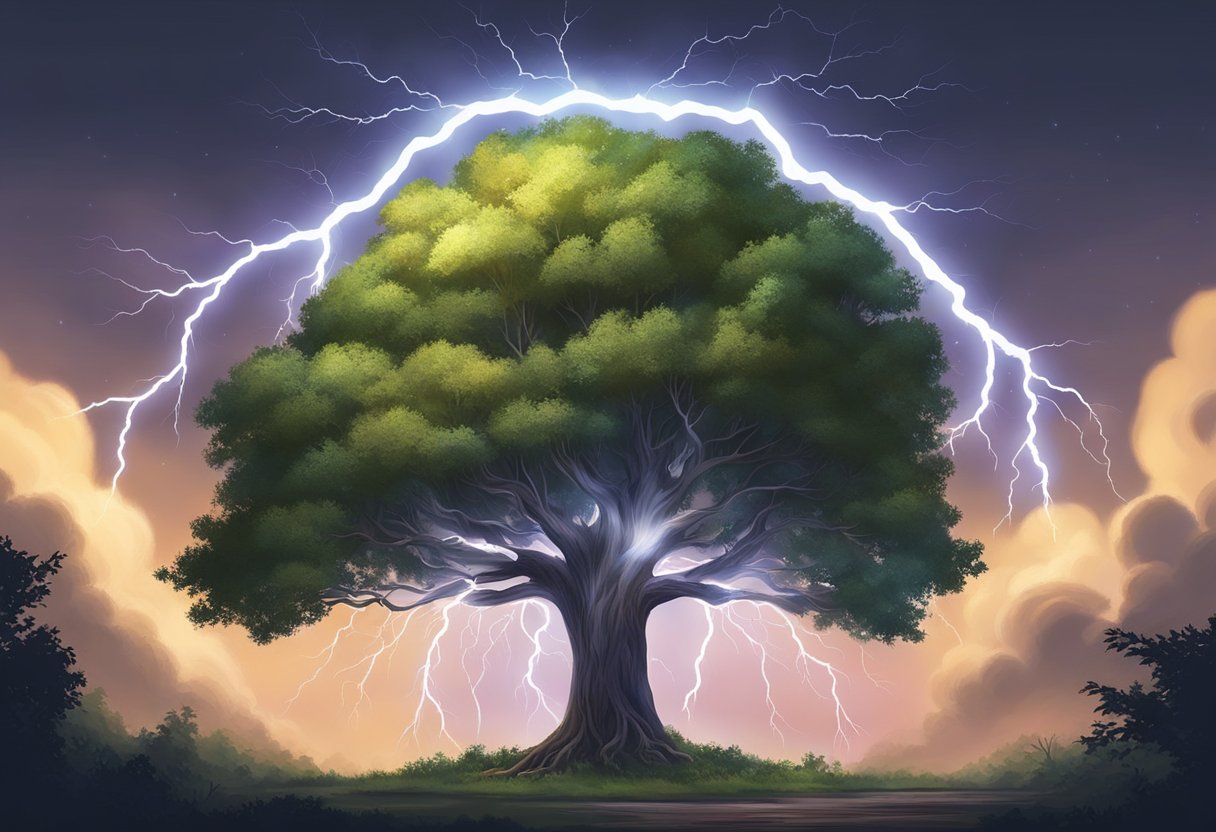Thundersnow: The Phenomenon Behind Winter Thunderstorms
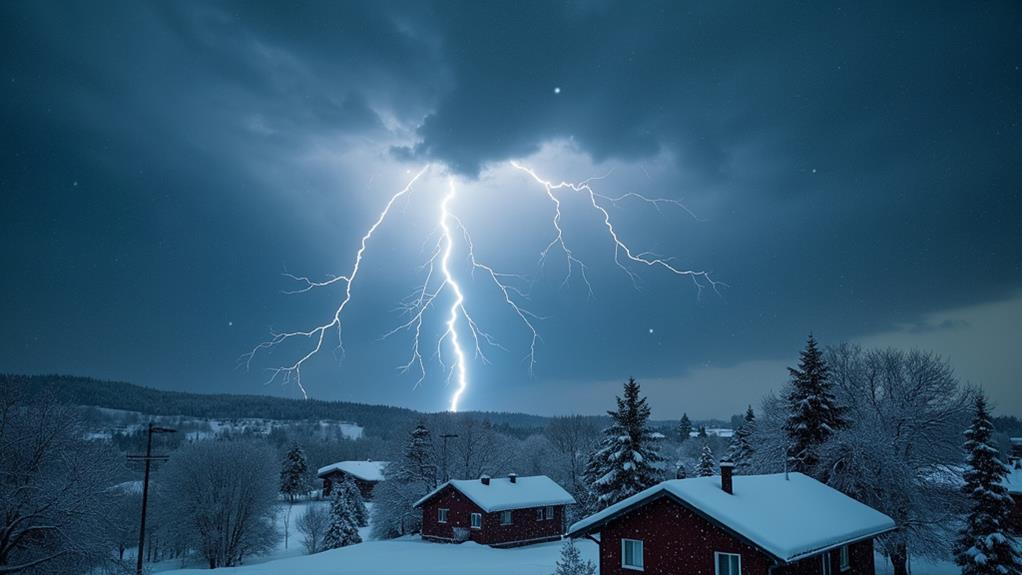
You experience the mesmerizing phenomenon of thundersnow when a winter storm generates heavy snowfall accompanied by thunder and lightning. Thundersnow requires specific atmospheric conditions, such as significant instability and moisture, typically found in intense storms like nor'easters. The muffled thunder creates a unique, low rumble, while visibility can dramatically decrease, making travel hazardous. Events are most common in the Great Lakes and northeastern U.S., but have been documented globally. Lightning can still occur, posing risks even in snowy conditions. Stick around to uncover more about this rare and enthralling winter storm event.
Key Takeaways
- Thundersnow is a rare winter thunderstorm where snow is the main precipitation, often in intense storms like nor'easters.
- It forms due to the interaction between warm, moist air near the surface and colder air aloft, requiring strong updrafts.
- Thundersnow produces cloud-to-cloud lightning, with muffled thunder due to the insulating effect of falling snow.
- Most common in the eastern U.S., especially around the Great Lakes, New England, and Nova Scotia.
- It poses hazards like reduced visibility, rapid snow accumulation, and lightning strikes, making travel dangerous.
Definition and Characteristics
Although it's a rare phenomenon, thundersnow is an enchanting event where a thunderstorm produces snow as the primary form of precipitation. This rare weather phenomenon typically occurs during intense winter storms, such as nor'easters, resulting in heavy snowfall rates that often exceed 2 inches per hour. Imagine witnessing thunder and lightning amid a snowstorm; it's a unique winter weather experience that leaves a lasting impression.
To experience thundersnow, specific atmospheric conditions need to align, including significant instability and ample moisture. These conditions are more likely to occur in regions like the northeastern United States, where winter storms are frequent. The thunder during thundersnow is usually muffled by the falling snow, creating a low rumble rather than the sharp crack you might expect in a summer thunderstorm. This muffled thunder can typically be heard within a mile or two.
Thundersnow can dramatically reduce visibility, making travel and outdoor activities hazardous. The rapid accumulation of snow combined with the flash of lightning and the muted sound of thunder creates an otherworldly atmosphere. Witnessing thundersnow is rare, but when you do, it's an unforgettable moment blending the power of a thunderstorm with the serene beauty of winter.
Occurrence and Global Instances
Thundersnow, while rare, has captivated weather enthusiasts and scientists alike with its striking occurrences across the globe. This rare phenomenon is most commonly observed in the eastern regions of the United States, especially around the Great Lakes, where specific atmospheric conditions prevail. New England and Nova Scotia have also experienced notable thundersnow events, often accompanied by severe thunderstorm warnings due to their intensity.
Globally, thundersnow lightning has been documented in places you wouldn't expect. For instance, Brazil has seen occurrences in 1984, 2005, and 2011, while Scotland and Poland have also noted rare instances of this winter weather marvel. Even typically milder climates aren't exempt; Vancouver, BC, reported a significant thundersnow event on December 17-18, 2022.
Here are some moments that might evoke a sense of awe and wonder:
- Bright lightning strikes illuminating a snow-covered landscape
- The eerie silence of snow broken by the crack of thunder
- The thrill of witnessing a rare weather phenomenon in your own backyard
- The surprise of thundersnow in unexpected regions like Brazil
These global instances highlight thundersnow's rarity but also its widespread potential, making each occurrence a moment to be cherished.
Formation Mechanisms
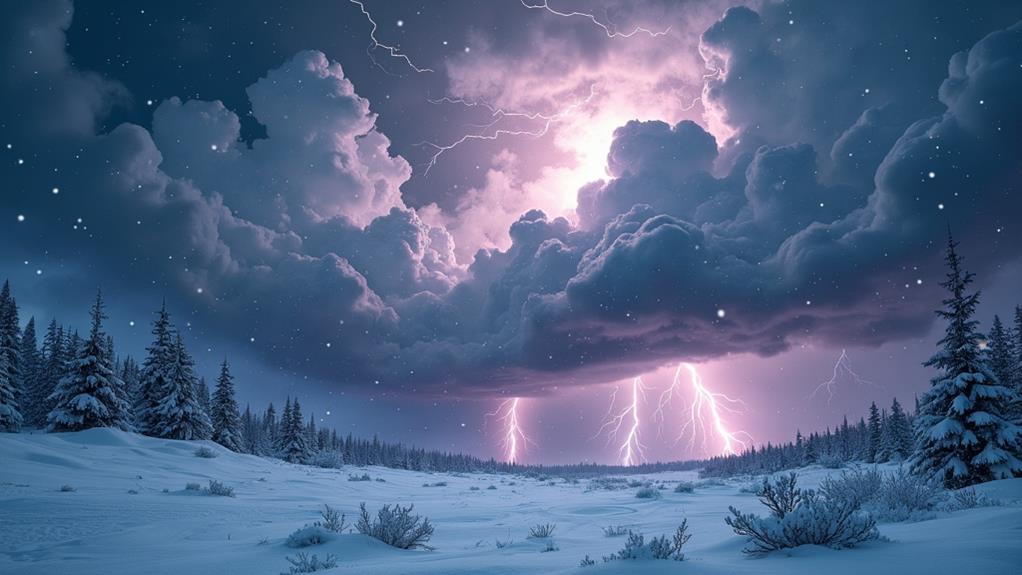
The formation of thundersnow hinges on the dynamic interplay between warm, moist air near the surface and colder air aloft, which creates the strong updrafts necessary for thunderstorm development. This atmospheric instability often occurs during winter storms, such as nor'easters, where extratropical cyclones provide the needed conditions. The warm air rises rapidly, meeting the cold air above, fostering significant vertical motions within the storm.
As these vertical motions, including updrafts and downdrafts, occur, they facilitate the critical collision of ice crystals and supercooled liquid water. This interaction leads to charge separation, where different particles acquire opposite electrical charges. Once enough charge builds up, lightning can occur, even amidst heavy snowfall, resulting in the phenomenon known as thundersnow.
To support the development of these electrical charges, the storm must have a convective depth of at least 1,500 meters (4,900 feet). Furthermore, regions prone to lake-effect snow can experience improved thundersnow formation. Here, cold air passing over warmer water increases thermal instability and moisture availability, further promoting the necessary conditions for thundersnow. Understanding these mechanisms reveals the remarkable complexity behind this rare winter weather event.
Hazards and Safety
While the formation mechanisms of thundersnow reveal its fascinating complexity, it's vital to recognize the hazards it brings. Thundersnow events can severely limit visibility due to heavy snowfall rates, often exceeding 2 inches per hour. This rapid snow accumulation creates hazardous driving conditions, making travel perilous. Lightning strikes, though less frequent than in summer storms, can still cause significant property damage and pose a risk to individuals caught outdoors.
Staying indoors during a thundersnow event is critical for your safety. The combination of reduced visibility and the danger from lightning strikes makes venturing outside risky. Furthermore, the acoustic dampening effect of snow can obscure the intensity and distance of thunder, making it difficult to gauge the danger posed by lightning.
To guarantee your safety during these intense winter weather events, it's wise to prepare an emergency kit. Include necessities like blankets, food, and water in case of power outages.
Here are some reasons why thundersnow hazards should not be underestimated:
- Limited visibility can lead to dangerous driving conditions.
- Rapid snow accumulation makes travel perilous.
- Lightning strikes pose significant risks.
- Potential power outages require an emergency kit.
Prioritize your safety during thundersnow events and be prepared for the unexpected.
Lightning and Acoustics
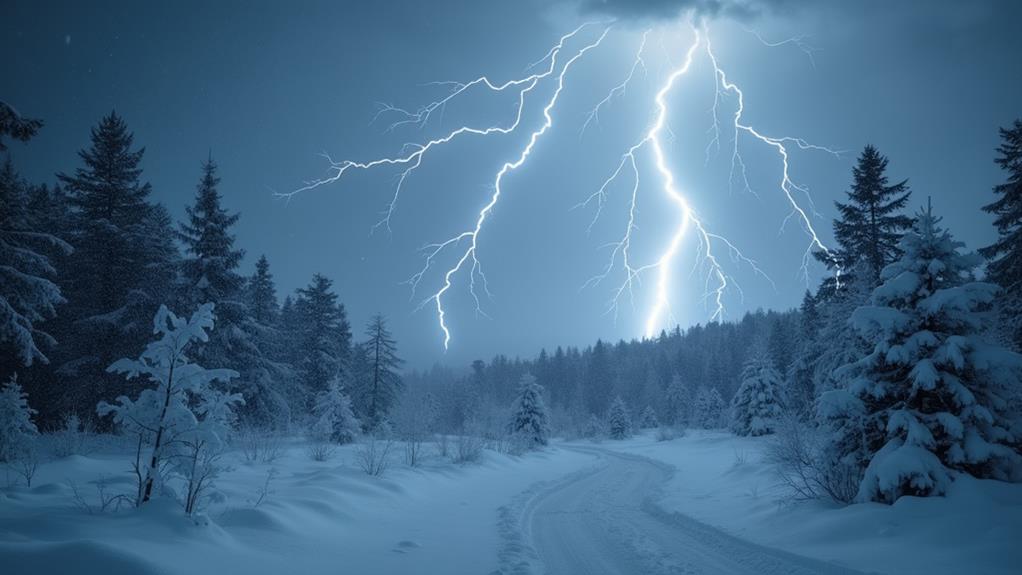
Although it may seem counterintuitive, thundersnow often produces mainly cloud-to-cloud lightning, with ground strikes being less frequent than in summer thunderstorms. This is due to the rapid vertical motions within the clouds, which facilitate charge separation, a key factor in lightning generation even in colder winter conditions.
When you experience thundersnow, you might notice that the flashes of lightning are fewer but can be larger and longer-lasting. This unique characteristic is partly due to the atmospheric conditions prevalent in winter thunderstorms. However, the acoustics of thundersnow are quite different from typical storms. The sound of thunder is often muffled by the insulating effect of the falling snow. This heavy snowfall dampens the sound, resulting in a low rumble that can be challenging to hear and gauge regarding intensity and distance.
Understanding the acoustics is essential because it affects how we perceive the storm's severity. Since the snowfall obscures the thunder sound, it can be difficult to judge how close or dangerous the lightning might be. So, during a thundersnow event, be aware that the thunder you hear might not fully represent the storm's power.
Historical Records
Thundersnow events have fascinated meteorologists and weather enthusiasts alike, with documented occurrences spanning different regions worldwide. The phenomenon is relatively rare, making each instance a remarkable event. In the United States, northeastern states like Massachusetts and New York often see thundersnow during intense winter storms, with severe thunderstorm warnings issued by the National Weather Service.
Historical records show that thundersnow is sporadic. For example, northern New England experiences it roughly once every year or two. Significant documented occurrences include:
- November 2018: Texas and Oklahoma witnessed substantial thundersnow events.
- March 2021: Laramie County, Wyoming, experienced a rare thundersnow episode.
- Scotland and Poland: These countries have also seen thundersnow, proving it's not confined to North America.
The sporadic nature of thundersnow makes it a striking phenomenon. A lightning strike during a winter thunderstorm is exciting for both scientists and the public. With advancements in detection technologies and social media, more thundersnow occurrences are being reported, adding to the historical records. Each documented instance further enriches our understanding of these rare winter thunderstorms, making them a compelling subject to study and witness.
Research and Media Coverage
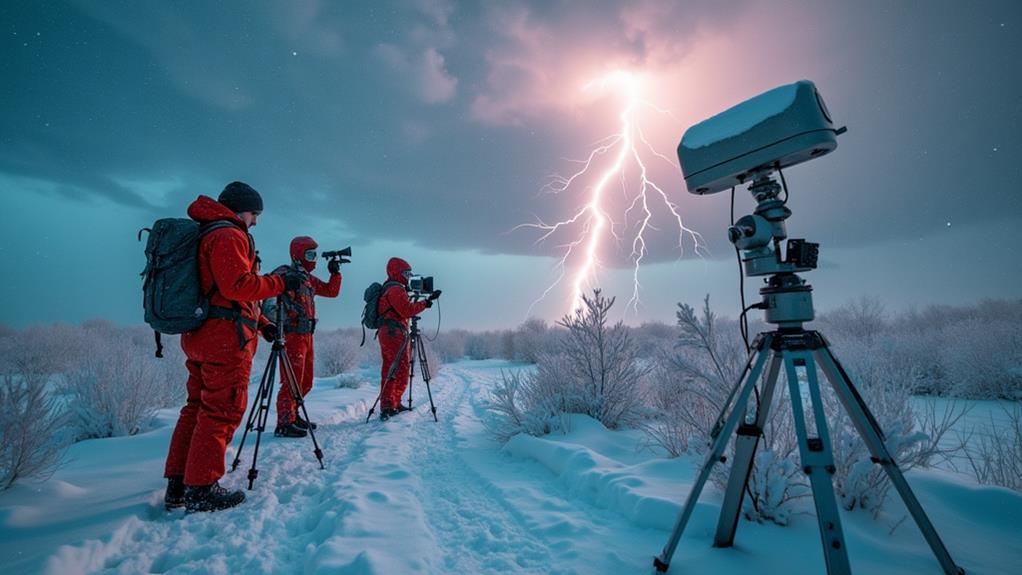
Meteorologists and weather enthusiasts aren't the only ones captivated by thundersnow; researchers and the media have also taken a keen interest in this rare phenomenon. Advancements in detection technology have spurred an increase in research on thundersnow, allowing meteorologists to study its occurrence and characteristics more effectively. Studies published in journals like "Weather and Forecasting" explore the specific atmospheric conditions necessary for thundersnow, enriching our understanding of this unique weather event.
The National Weather Service continuously conducts research to improve forecasting methods for thundersnow, focusing on its unique electrical and atmospheric properties. This ongoing research is essential for enhancing public awareness and safety during winter storms.
Media coverage plays an important role in disseminating information about significant thundersnow events. News outlets often include safety tips and travel advisories, providing real-time updates that help you stay safe during these intense winter conditions. Social media platforms further amplify this information, enabling communities to share experiences and receive timely weather alerts.
Frequently Asked Questions
How Rare Is a Thundersnow Storm?
Imagine a thunderstorm's roar combined with the serene fall of snowflakes. Thundersnow is rare, with a frequency of about once every year or two in northern New England. This winter phenomenon needs unique thunderstorm conditions—cold air, moisture, and atmospheric instability. Climate change effects might alter winter weather patterns, potentially increasing snowfall intensity. Historical thundersnow events highlight its sporadic nature, but new detection tech suggests it's more common than we thought.
What Is the Old Wives Tale About Thunder in Winter?
You've probably heard the old wives' tale that hearing thunder in winter means a brutal, snowy season is coming. This winter folklore ties thunder superstitions to severe cold weather. Such seasonal beliefs stem from weather lore, suggesting thunder during snowstorms predicts heavy snowfall. Although rooted in folklore origins, atmospheric phenomena actually explain these occurrences. Thunder meanings in this situation aren't reliable indicators of future precipitation patterns but fascinating snow myths.
Why Are Winter Thunderstorms Rare?
Winter thunderstorms are rare due to the unique conditions required for thundersnow formation. Cold air aloft, warm air at the surface, and sufficient moisture presence are essential. Atmospheric instability is less common in winter, and geographical factors and seasonal patterns play a role. Temperature gradients need to align perfectly. Snow intensity can muffle thunder sounds, making it harder to notice. Weather forecasting often misses these specific criteria, adding to their rarity.
Has There Ever Been a Lightning Snow Storm?
Think of a lightning snow storm like a firework show in a snow globe. Yes, there have been lightning snow storms reported, with notable occurrences in places like Massachusetts and New York. These storms combine high lightning frequency with intense snow accumulation. Winter precipitation, driven by thunderstorm intensity, relies on unique atmospheric conditions like temperature inversion and moisture content. Seasonal patterns and storm tracking reveal their rarity, with significant climate impact.

